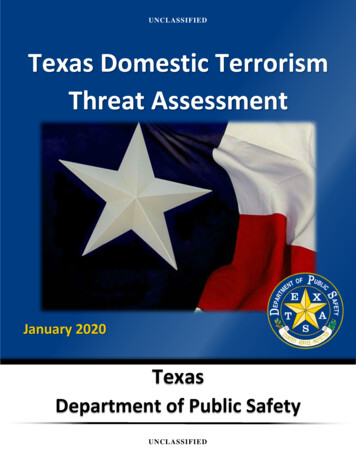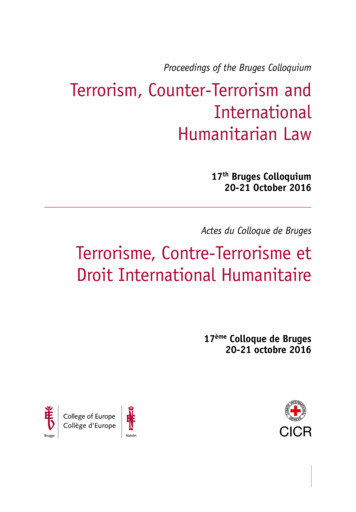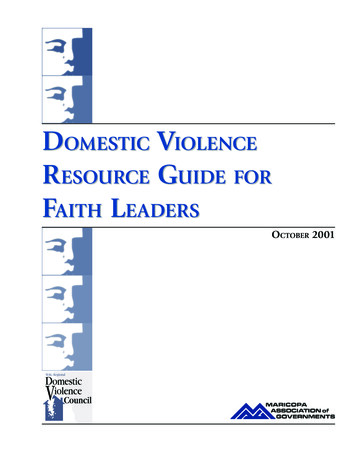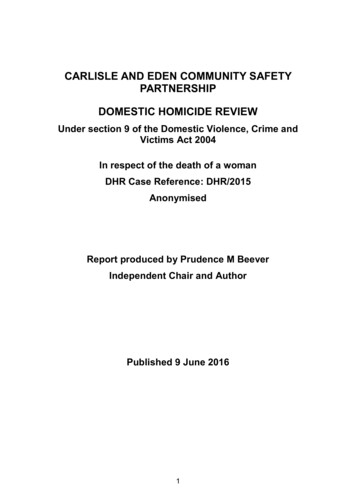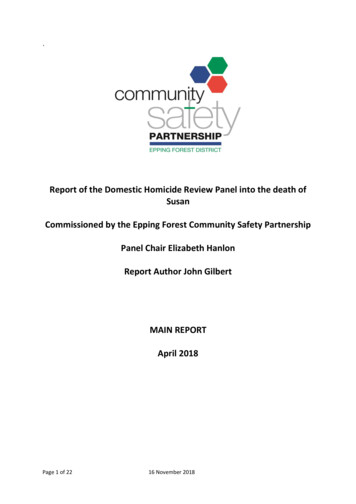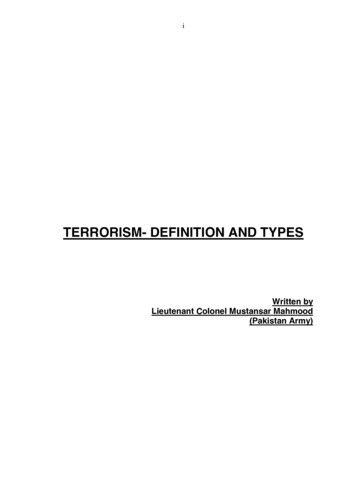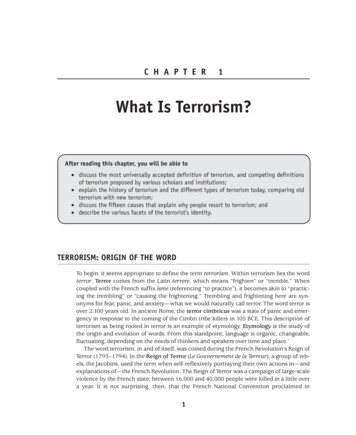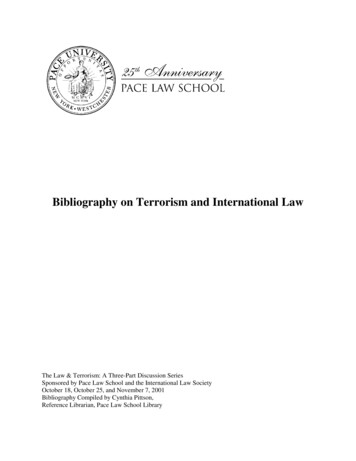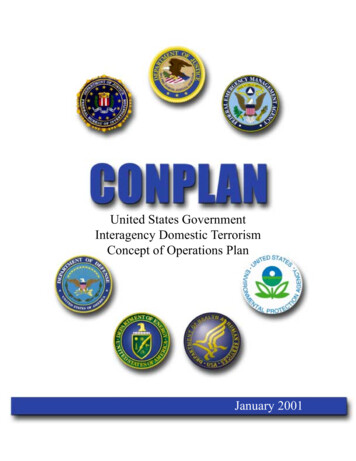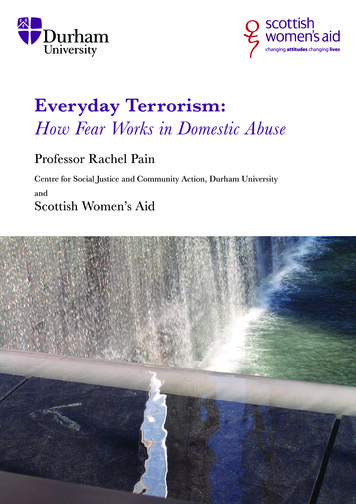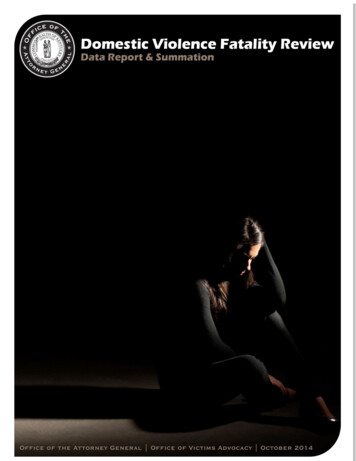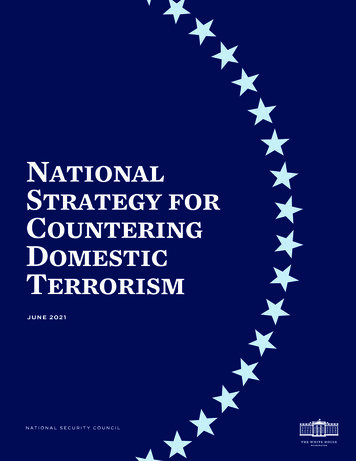
Transcription
Too often over the past several years, American communities have felt thewrenching pain of domestic terrorism. Black church members slaughteredduring their bible study in Charleston. A synagogue in Pittsburgh targetedfor supporting immigrants. A gunman spraying bullets at an El Paso Walmartto target Latinos. It goes against everything our country strives to stand forin the world, and it poses a direct challenge to America’s national security,our democracy, and our national unity. This National Strategy for CounteringDomestic Terrorism lays out a comprehensive approach to addressing the threatwhile safeguarding bedrock American civil rights and civil liberties – values thatmake us who we are as a nation.Americans hold a wide array of beliefs. That is part of what makes the UnitedStates such a diverse and extraordinary nation. Preserving and safeguardingconstitutionally protected expression and freedom of association are nationalsecurity priorities. Our rights and our historic liberties are an intrinsic partof what makes America strong. So this Strategy is narrowly tailored to focus
specifically on addressing violence and the factorsthat lead to violence – violence that violates the law,threatens public safety, and infringes on the freeexpression of ideas.We cannot ignore this threat or wish it away.Preventing domestic terrorism and reducing the factorsthat fuel it demand a multifaceted response acrossthe Federal Government and beyond. That includesworking with our critical partners in state, local, tribal,and territorial governments and in civil society, theprivate sector, academia, and local communities, as wellthis is aprojectthat shouldUnite AllAmericansas with our allies and foreign partners. We have to takeboth short–term steps to counter the very real threatsof today and longer–term measures to diminish theemerging threats of tomorrow.This is a project that should unite all Americans.Together we must affirm that domestic terrorism hasno place in our society. We must work to root out thehatreds that can too often drive violence. And we mustrecommit to defend and protect those basic freedoms,which belong to all Americans in equal measure, andwhich are not only the foundation of our democracy—they are our enduring advantage in the world.Joseph R. Biden Jr.togetherwe mustaffirm thatdomesticterrorismhas noplace inour society
Table of ContentsI.IntroductionII.Today’s ThreatIII. Our Approach4IV.Strategic PillarsV.The Way AheadNational Strategy for Countering Domestic Terrorism
IntroductionDomestic terrorism is not a new threat in the United States. It has, over centuries, taken manyAmerican lives and spilled much American blood – especially in communities deliberately andviciously targeted on the basis of hatred and bigotry. After the Civil War, for example, the KuKlux Klan waged a campaign of terror to intimidate Black voters and their white supportersand deprive them of political power, killing and injuring untold numbers of Americans.The Klan and other white supremacists continued to terrorize Black Americans and otherminorities in the decades that followed. In recent years, we have seen a resurgence of thisand related threats in one horrific incident after another: the shooting and killing of 23 peopleat a retail store in El Paso; the vehicular killing of a peaceful protestor in Charlottesville; theshooting and killing of three people at a garlic festival in Gilroy; the arson committed at amosque in Victoria, Texas; the appalling rise in violence and xenophobia directed against AsianAmericans; the surge in anti–Semitism; and more.Domestic terrorist attacks in the United States also have been committed frequently by thoseopposing our government institutions. In 1995, in the largest single act of domestic terrorismin U.S. history, an anti–government violent extremist detonated a bomb at the Alfred P. MurrahFederal Building in Oklahoma City, killing 168 people – including 19 children – and injuringhundreds of others. In 2016, an anti–authority violent extremist ambushed, shot, and killedfive police officers in Dallas. In 2017, a lone gunman wounded four people at a congressionalbaseball practice. And just months ago, on January 6, 2021, Americans witnessed anunprecedented attack against a core institution of our democracy: the U.S. Congress.Some aspects of the Federal Government’s response also are not new. During Reconstruction,the U.S. Department of Justice was created and immediately focused on prosecuting andconvicting hundreds of Klan members in connection with their vicious campaign of domesticterrorism. In the 1980s, Joint Terrorism Task Forces, now a nationwide staple of Federal, state,local, tribal, and territorial law enforcement cooperation against all forms of terrorism, werecreated to maximize information sharing and address the full range of terrorism threats, bothdomestic and international. While domestic terrorism’s roots and elements of our responsemay be longstanding, domestic terrorism is both persistent and evolving – and, according toNational Strategy for Countering Domestic Terrorism5
the U.S. Intelligence Community and law enforcement, “elevated” in the threat it now poses.This National Strategy for Countering Domestic Terrorism provides an overarching approachto address today’s manifestation of the domestic terrorism threat as well as the evolving formsthat the threat may take in the years ahead.The intelligence and law enforcement communities have articulated publicly the threat posedby domestic terrorism today. That articulation draws on the comprehensive assessment ofthe threat that President Biden requested on his first full day in office. That assessment wasconducted by appropriate elements of the U.S. Government and provided to the President. Itwas also released publicly in summary form on March 17, 2021 (see page 10). Today’s domesticterrorists espouse a range of violent ideological motivations, including racial or ethnic bigotry“domestic terrorism is bothpersistent and evolving.and hatred as well as anti–government or anti–authority sentiment. They also take on a varietyof forms, from lone actors and small groups of informally aligned individuals, to networksexhorting and targeting violence toward specific communities, to violent self–proclaimed“militias” who, despite legal prohibitions in all fifty states against certain private militiaactivity, assert a baseless right to take the law into their own hands. Across violent ideologies,individuals and small groups – both formal and informal – have been galvanized by recentpolitical and societal events in the United States to carry out violent attacks. Among that widerange of animating ideologies, racially or ethnically motivated violent extremists (principallythose who promote the superiority of the white race) and militia violent extremists areassessed as presenting the most persistent and lethal threats.We are taking on this complex and evolving domestic terrorism threat landscape with anapproach that honors and protects both America’s security and America’s values, especiallyour cherished civil rights and civil liberties. Addressing domestic terrorism effectively,responsibly, and sustainably demands forging a government–wide effort while protectingthe rule of law and distinctive law enforcement prerogatives. That involves policies thatprotect the independence and integrity of the Department of Justice, including the FederalBureau of Investigation; bolstering efforts that address domestic terrorism across the FederalGovernment and renewing partnerships with state, local, tribal, and territorial governmentsas well as civil society, the private sector, and beyond; and focusing specifically on terrorist6National Strategy for Countering Domestic Terrorism
violence and the factors that contribute to it while safeguarding constitutionally protectedactivity. Doing so will propel the United States toward the ultimate goal of stopping acts ofdomestic terrorism. It will also help us to reduce the factors contributing to incitement todomestic terrorism online that exacerbate the spread of calls to violence. It will, moreover,guide the United States toward achieving the resilience that can prevent domestic terroristsfrom gaining traction and adherents in the first place.This Strategy is organized around four pillars – the core elements of how the U.S. Governmentwill tackle the threat posed by domestic terrorism today. First are efforts to understand andshare information regarding the full range of domestic terrorism threats. Second are efforts toprevent domestic terrorists from successfully recruiting, inciting, and mobilizing Americansto violence. Third are efforts to deter and disrupt domestic terrorist activity before it yieldsviolence. Finally, the long–term issues that contribute to domestic terrorism in our countrymust be addressed to ensure that this threat diminishes over generations to come.We must be clear–eyed about this challenge: the unlawful violence that constitutes domesticterrorism is the result of a complex, multi–layered set of societal dynamics. We cannot – and“our approach honorsand protects bothamerica’s securityand america’scherished civilrights and civilliberties.will not – ignore those dynamics, such asracism and bigotry that perpetuate thedomestic terrorism threat. That is whythis Strategy’s fourth pillar lays out long–term visions for addressing them. At thesame time, this is a Strategy specificallyfocused on the terrorist violence that, alltoo often, turns those broad dynamicsinto particular loss and heartache. Evenas we look to address these underlying dynamics over the long term, we must focus intensely– as this Strategy does – on the threat of violence that faces us right now.All told, today’s domestic terrorism threat poses a danger to Americans, our democraticsociety, and our national security that we must counter aggressively, comprehensively, andresponsibly. Doing so will make America not just safer, but also stronger – and more unified.What follows is America’s first government–wide national Strategy to do so.National Strategy for Countering Domestic Terrorism7
Today’s ThreatDomestic terrorism poses a serious and evolving threat. A provision of Federal law defines“domestic terrorism” as “activities that involve acts dangerous to human life that are a violationof the criminal laws of the United States or of any State; appear to be intended to intimidateor coerce a civilian population, to influence the policy of a government by intimidation orcoercion, or to affect the conduct of a government by mass destruction, assassination, orkidnapping; and occur primarily within the territorial jurisdiction of the United States.” Overtime, domestic terrorism threats in the United States have ebbed and flowed, reflected differentmotivating ideologies, and demanded varying governmental responses. Today’s domesticterrorism threat, as assessed comprehensively by America’s intelligence and law enforcementprofessionals in early 2021, involves a complex mix of elements.According to this assessment, one key aspect of today’s domestic terrorism threat emergesfrom racially or ethnically motivated violent extremists and networks whose racial, ethnic,or religious hatred leads them toward violence, as well as those whom they encourage totake violent action. These actors have different motivations, but many focus their violencetowards the same segment or segments of the American community, whether persons of color,immigrants, Jews, Muslims, other religious minorities, women and girls, LGBTQI individuals,or others. Their insistence on violence can, at times, be explicit. It also can, at times, be lessexplicit, lurking in ideologies rooted in a perception of the superiority of the white race thatcall for violence in furtherance of perverse and abhorrent notions of racial “purity”or “cleansing.”Another key component of the threat comes from anti–government or anti–authority violentextremists. This significant component of today’s threat includes self–proclaimed “militias”and militia violent extremists who take steps to violently resist government authority orfacilitate the overthrow of the U.S. Government based on perceived overreach; anarchistviolent extremists, who violently oppose all forms of capitalism, corporate globalization, andgoverning institutions, which they perceive as harmful to society; sovereign citizen violentextremists, who believe they are immune from government authority and laws; or any other8National Strategy for Countering Domestic Terrorism
individual or group who engages in violence – or incites imminent violence – in opposition tolegislative, regulatory, or other actions taken by the government. Other domestic terroristsmay be motivated to violence by single–issue ideologies related to abortion–, animal rights–,environmental–, or involuntary celibate–violent extremism, as well as other grievances – ora combination of ideological influences. In some cases, individuals may develop their ownidiosyncratic justifications for violence that defy ready categorization.“domestic terrorists have often been loneactors or small groups of informally alignedindividuals.Domestic terrorists have – particularly in recent years – often been lone actors or small groupsof informally aligned individuals who mobilize to violence with little or no clear organizationalstructure or direction. These individuals often consume material deliberately disseminatedto recruit individuals to causes that attempt to provide a sense of belonging and fulfillment,however false that sense might be. Their ideologies can be fluid, evolving, and overlapping.And they can, in some instances, connect and intersect with conspiracy theories and otherforms of disinformation and misinformation. The often solitary and, at times, rapid natureof such mobilization to violence poses a particularly acute challenge to law enforcement andothers seeking to prevent, disrupt, and deter domestic terrorism.These elements combine to form a complex and shifting domestic terrorism threat landscapeand create significant challenges for law enforcement. Especially on Internet–basedcommunications platforms such as social media, file–upload sites, and end–to–end encryptedplatforms, all of these elements can combine and amplify threats to public safety. This is thedomestic terrorism threat America faces today – one with the distinctive imprint of today’sdigital age as well as longstanding roots in domestic terrorism challenges throughout ourcountry’s history. Tackling that threat comprehensively and persistently demands appreciatingboth its historical lineage and its distinctively modern form.National Strategy for Countering Domestic Terrorism9
Assessment of the DomesticViolent Extremism ThreatMarch 2021The Intelligence Community (IC) assesses that domestic violent extremists(DVEs) who are motivated by a range of ideologies and galvanized by recentpolitical and societal events in the United States pose an elevated threatto the Homeland in 2021. Enduring DVE motivations pertaining to biasesagainst minority populations and perceived government overreach willalmost certainly continue to drive DVE radicalization and mobilization toviolence. Newer sociopolitical developments–such as narratives of fraud inthe recent general election, the emboldening impact of the violent breachof the U.S. Capitol, conditions related to the COVID–19 pandemic, andconspiracy theories promoting violence–will almost certainly spur someDVEs to try to engage in violence this year.The IC assesses that lone offenders or small cells of DVEs adhering to adiverse set of violent extremist ideologies are more likely to carry out violentattacks in the Homeland than organizations that allegedly advocate a DVEideology. DVE attackers often radicalize independently by consuming violentextremist material online and mobilize without direction from a violentextremist organization, making detection and disruption difficult.The IC assesses that racially or ethnically motivated violent extremists(RMVEs) and militia violent extremists (MVEs) present the most lethal DVEthreats, with RMVEs most likely to conduct mass–casualty attacks againstcivilians and MVEs typically targeting law enforcement and governmentMarch 2021 Threat Assessment10National Strategy for Countering Domestic Terrorism
personnel and facilities. The IC assesses that the MVE threat increased lastyear and that it will almost certainly continue to be elevated throughout 2021because of contentious sociopolitical factors that motivate MVEs to commitviolence.The IC assesses that U.S. RMVEs who promote the superiority of thewhite race are the DVE actors with the most persistent and concerningtransnational connections because individuals with similar ideological beliefsexist outside of the United States and these RMVEs frequently communicatewith and seek to influence each other. We assess that a small number of USRMVEs have traveled abroad to network with like–minded individuals.The IC assesses that DVEs exploit a variety of popular social mediaplatforms, smaller websites with targeted audiences, and encrypted chatapplications to recruit new adherents, plan and rally support for inpersonactions, and disseminate materials that contribute to radicalization andmobilization to violence.The IC assesses that several factors could increase the likelihood or lethalityof DVE attacks in 2021 and beyond, including escalating support frompersons in the United States or abroad, growing perceptions of governmentoverreach related to legal or policy changes and disruptions, and high–profileattacks spurring follow–on attacks and innovations in targeting and attacktactics.DVE lone offenders will continue to pose significant detection and disruptionchallenges because of their capacity for independent radicalization toviolence, ability to mobilize discretely, and access to firearms.March 2021 Threat AssessmentNational Strategy for Countering Domestic Terrorism11
Our ApproachAddressing domestic terrorism effectively, responsibly, and enduringly requires moving swiftlybut sustainably; creatively but carefully; and decisively but deftly. Our approach will protectboth the nation and the civil liberties of its citizens.We will forge a government–wide effort while safeguarding distinctive law enforcementprerogatives, such as those that belong to the Department of Justice, including the FederalBureau of Investigation, and safeguarding critical patient provider relationships like thosemaintained by the Department of Veterans Affairs providers with veterans. Particularinvestigatory and prosecutorial decisions are for law enforcement alone, unaffected by andinsulated from any political influence or bias. At the policy level, this Strategy demandsthat the broader Federal Government coordinate and collaborate on programmatic aspectsof countering domestic terrorism, such as information sharing, training, prevention, andintervention efforts. It thus sets a pathway for a unity of effort at the policy level, whileprotecting the specific work of law enforcement that must be left wholly to appropriate lawenforcement entities, whether Federal, state, local, tribal, or territorial.We will also build a community to address domestic terrorism that extends not only acrossthe Federal Government but also to critical partners. That includes state, local, tribal, andterritorial governments, as well as foreign allies and partners, civil society, the technologysector, academia, and more. Domestic terrorism and the factors that contribute to it pose achallenge best tackled by a set of interlocking communities that can contribute information,expertise, analysis, and more to addressing this multifaceted threat. With the right orientationand partnerships, the Federal Government can energize, connect, and empower thosecommunities – communities whose input was critical to the formulation of this Strategy itself.Furthermore, we will focus specifically on violence and factors which contribute to it whilerespecting civil rights, civil liberties, and privacy protections, and while recognizing andmaximizing the positive benefits of modern communications technologies such as the Internet.The First Amendment to the U.S. Constitution, as well as other U.S. law, protects a wide range12National Strategy for Countering Domestic Terrorism
of expression – even expression that many might disagree with or find abhorrent, and evenexpression that certain foreign allies and partners of the United States prohibit and criminalizeunder their own laws. Ours is a distinctively American tradition of robust speech; and it is atradition we cherish. Violence and its incitement, however, are generally neither toleratednor protected; indeed, violence is generally criminal, as are incitement to imminent violenceand true threats of violence. This Strategy focuses specifically on unlawful violence that posesa threat to public safety, to national security, and to the genuine free expression of ideas –indeed, to our democracy. Our country and its laws leave wide open the space for political andideological views and their articulation, including through peaceful protest. But they leave noroom for unlawful violence. This Strategy is designed to preserve the former while preventingthe latter.It is critical that we condemn and confront domestic terrorism regardless of the particularideology that motivates individuals to violence. The definition of “domestic terrorism” inour law makes no distinction based on political views – left, right, or center – and neithershould we. We must disrupt and deter those who use violence to intimidate racial or religious“minorities, who have so often been the victimsit is criticalthat wecondemn andconfrontdomesticterrorismregardless ofthe particularideology thatmotivatesindividuals toviolence.of hateful extremists. So too must we disruptand deter those who launch violent attacks in amisguided effort to force change in governmentpolicies that they view as unjust. In a democracy,there is no justification for resorting to violence toresolve political differences.We will do all of this with a singular goal: stoppingacts of domestic terrorism. Domestic terrorismhas taken the lives of too many Americans inrecent years, injuring still more and leaving behindgrieving families and friends. The overarchinggoal of this Strategy is preventing, disrupting,and deterring that violence. Pursuing that goalincludes reducing the factors contributing to domestic terrorism. Those factors have multipledimensions, including incitement to imminent violence online, some transnational linkages,and certain self–proclaimed private “militia” activity that, to varying degrees, is prohibitedby the laws of all 50 states. Addressing these factors contributing to domestic terrorism is, inpart, a means to achieving the first objective of preventing the violence itself and handling thethreats we face today; but it must also be its own objective, as reducing the contributing factorscan make a difference in diminishing the threat we might otherwise face tomorrow.National Strategy for Countering Domestic Terrorism13
Additionally, pursuing the goal of preventing, disrupting, and deterring acts of domesticterrorism means achieving the type of resilience that can prevent domestic terrorists fromgaining traction and adherents in the first place. Resilience can take many forms. It can meanraising public awareness of how terrorists deliberately seek overreaction, which can help toavoid precisely that overreaction and instead thwart terrorists’ own strategies. And it canmean, broader still, cultivating the type of digital literacy that can empower the Americanpublic to resist those who would use online communications platforms and other venues torecruit, radicalize, and mobilize to violence. Fostering and ultimately attaining these and otherforms of resilience is a third goal, and one whose achievement would strengthen the UnitedStates against domestic terrorism as well as other threats to U.S. national security.14National Strategy for Countering Domestic Terrorism
Strategic PillarsToday’s domestic terrorism threat is complex, multifaceted, and evolving. There is no singleaction or single part of the U.S. Government that can address the entirety of that threat. Thefollowing four pillars, implemented in an integrated manner across relevant parts of theFederal Government and in close coordination with non–Federal partners, will guide the U.S.Government’s response to the threat summarized above. As noted above, implementationof this Strategy will proceed in parallel with, and be complementary to, the work of lawenforcement to investigate suspected criminal activity and prosecute those who break our laws.pillar one understand and share domesticterrorism–related informationStrategic Goal 1.1: Enhance domestic terrorism–related researchand analysis.Addressing any threat effectively requires understanding it thoroughly. For today’s shifting anddiverse domestic terrorism threat, that task is imperative. The Federal Government continuesto augment and improve how the domestic terrorism threat is analyzed and understood.Analyses of key trends and trajectories are now regularly generated by the Federal Bureauof Investigation and Department of Homeland Security, with support from the NationalCounterterrorism Center and others as appropriate, and then shared widely across the FederalGovernment. These analyses benefit from the continued tracking of domestic terrorism–relatedinvestigations and prosecutions across Federal law enforcement and nationwide and, moreover,will benefit from increased exploration of publicly available, threat–related information,consistent with applicable law and guidelines. Additionally, a comprehensive understandingof the domestic terrorism threat landscape requires facilitating a systematic provision ofinformation and data to the appropriate parts of the Federal Government from state, local,tribal, and territorial partners who often identify and disrupt manifestations of the domesticNational Strategy for Countering Domestic Terrorism15
“the federal government continues to augmentand improve how the domestic terrorismthreat is analyzed and understood.terrorism threat, even if they do not always use the same labels to describe it. That is whythe Federal Government is enhancing its ability to receive and analyze domestic terrorismthreat information provided by state, local, tribal, and territorial partners, as well as improvingits coordinated dissemination of that information. Doing so will inform more fully not onlyexecutive branch officials, but also the Congress and the American people as they seek tounderstand the domestic terrorism threat facing the nation today.Maximizing the Federal Government’s understanding of this particular threat also meanssupporting and making appropriate use of the analysis performed by entities outside thegovernment that bring to bear relevant expertise and doing so in a structured way thatprovides a channel for such analysis while also avoiding bias or improper influence – or eventhe appearance of it. To that end, and consistent with civil liberties and privacy protections,the Department of Homeland Security will introduce a new systematic approach for utilizingpertinent external, non–governmental analysis and information that will provide enhancedsituational awareness of today’s domestic terrorism threat. That includes, where appropriate,specialized areas and types of analysis, including ways in which gender–motivated violencecan have implications for domestic terrorist threats.Strategic Goal 1.2: Improve information sharing across all levelswithin, as well as outside, the Federal Government.With this enhanced domestic terrorism–related research and analysis, the Federal Governmentmust continue to improve information sharing on domestic terrorism threats across thegovernment to ensure that all relevant Federal partners are equipped to take appropriatemeasures with this knowledge. Consistent with legal and policy limitations on the sharing ofsensitive law enforcement information, we will continue sharing information widely across theFederal enterprise, including, as noted above, through new efforts focused specifically on thedomestic terrorism threats that can be identified from open–source information.16National Strategy for Countering Domestic Terrorism
In addition, the Federal Government must constantly update and advance its efforts to sharerelevant information externally, as some of the first to identify a potential threat of domesticterrorism are often state, local, tribal, or territorial partners, or those in their communities.That is why we have already increased our focus on information sharing with those partners,providing, at the unclassified level, more information, with more details, more quickly. Thisincludes publishing and disseminating intelligence products that provide our partners withgreater insight into the evolving threat, as well as situational awareness notifications to informpublic safety and security planning efforts in advance of potential violence. That emphasis onfuller, faster information sharing will continue and expand, as we are committed to ensuringthat state, local, tribal, and territorial partners receive not just warnings of specific, crediblethreats of violence but also, where appropriate, broader indicators and warnings that caninform our partners’ level and type of preparation for potential violence.As discussed further below, we are also developing new resources as part of our broadereffort to boost support to state, local, tribal, and territorial law enforcement in tacklingdomestic terrorism, including resources that will cover relevant iconography, symbology,and phraseology used by many domestic terrorists as well as dat
In 2017, a lone gunman wounded four people at a congressional baseball practice. And just months ago, on January 6, 2021, Americans witnessed an
